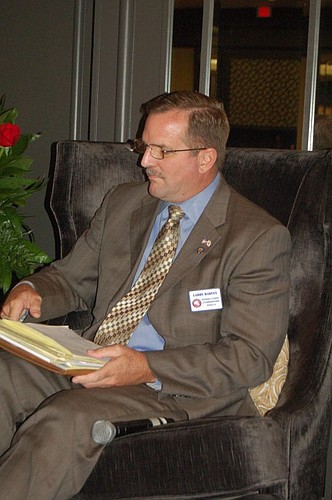
The questions associated with the potential economic and environmental impacts of deepening Jacksonville’s shipping channel have different responses depending on who’s answering them.
The main question — how to fund the $500 million-$700 million project — remains without an answer.
While the concept for the project has been approved by the federal government, no funds have been appropriated on the federal, state or local levels for dredging. All three will have to commit the funds before the project can begin.
Channel dredging was discussed Monday at the Rotary Club of Jacksonville by Brian Taylor, JaxPort CEO; St. Johns Riverkeeper Lisa Rinaman; Vince Cameron, president of the International Longshoremen’s Association Local 1408; and Larry Harvey, Putnam County Commissioner and director of operations for Save the Rodman Reservoir Inc.
Taylor said the project is in its third version. It was first envisioned to deepen the channel to 50 feet from the Atlantic Ocean to the Talleyrand terminal Downtown.
That plan was scaled back to dredging the channel to 47 feet deep for 13 miles inside the St. Johns River at a cost of about $700 million.
The latest plan, which Taylor said is not settled on, would deepen the channel to 47 feet for a distance of 11 miles for about $500 million.
He said in the past five years, the port’s business has diversified from being primarily dependent on shipping to and from Puerto Rico to competing in the global market as well, particularly with shipping companies that call on ports in Asia.
Taylor said 57 percent of the port’s business comes from the Asian routes, which allowed the port to add more than 2,000 jobs. It also means larger ships that need more water under their keels stop in Jacksonville,
“If we don’t dredge, we could lose that business,” he said.
Cameron represents people who work on the docks handling the freight.
He said the global ocean shipping market is changing. Other East Coast ports are deepening their channels and improving their facilities.
Jacksonville also must improve its port to remain competitive and sustain the workforce.
“It’s a no-brainer for me. The port equals jobs,” he said.
St. Johns Riverkeeper Lisa Rinaman said despite a study published by the U.S. Army Corps of Engineers, her organization believes that deepening the channel will cause more seawater to enter the river.
That, she said, would damage wetlands, increase pollution and algae blooms and contribute to erosion.
Taylor said no data has been produced that disputes the corps’ findings, but Rinaman cited a similar study by the corps that predicted little environmental impact from deepening the Port of Miami.
“Their model said there would be no damage, but there was extensive damage,” Rinaman said.
Her organization supports removing the dam that created the Rodman Reservoir in Putnam County as a way to add more fresh water to the St. Johns River system to mitigate the environmental impact of the dredging project.
Rinaman said adding millions of gallons of fresh water each day to the river would restore 15,000 acres of wetlands and improve water quality and wildlife habitat.
In January Rinaman, joined by Mayor Alvin Brown, JAX Chamber and port authority officials, executed a memorandum of understanding to the effect they would work together to persuade the state to approve and fund breaching the dam at Rodman as part of environmental mitigation for the dredge project.
The Riverkeeper also agreed to forego litigation challenging the corps’ environmental impact report if the dam is removed.
Harvey said Save the Rodman Reservoir supports deepening the channel in Duval County. But, he said, removing the dam and eliminating the reservoir would do little to improve the ecosystem and it could have a negative impact on Putnam County’s economy.
Harvey said water already flows into and out of the reservoir and it has the largest population of large-mouth bass in the state, which each year attracts thousands of recreational anglers to the area.
“There is a huge economic benefit for Putnam County to leave Rodman the way it is,” said Harvey. “We support whatever you want to do in Jacksonville, just leave the reservoir alone.”
After the panel adjourned, JaxPort spokeswoman Nancy Rubin said the $7 million design and engineering phase of the project, which is complete, was funded by the state and federal governments. In addition, the state Department of Transportation has committed $11.6 million in its 2015-16 budget for the next step, the initial bid phase.
The federal government usually covers 65 percent of the cost of a harbor improvement project, with state and local funding accounting for the remaining 35 percent.
While neither the city nor federal governments yet have appropriated any funds for the project, Rubin said that doesn’t hinder the project proceeding.
“You don’t need the money the first day. You need the commitment for the money over time,” she said, referring to the estimated five- to six-year project duration.
@DRMaxDowntown
(904) 356-2466